Viewing: Blog Posts Tagged with: Art History, Most Recent at Top [Help]
Results 1 - 25 of 71
Blog: Children's Book Reviews and Then Some (Login to Add to MyJacketFlap)
JacketFlap tags: aauthor: Bird, Non-fiction, art history, art museum, Add a tag
Blog: OUPblog (Login to Add to MyJacketFlap)
JacketFlap tags: Music, History, violin, Biography, Music History, art history, Ashmolean, musical instruments, American National Biography, Online products, Arts & Humanities, italian renaissance, Carleen Hutchins, Hidden History of New Hampshire, Quincy Whitney, Add a tag
Biography chooses us when there is alchemy between biographer and subject—a perfect fit of interlocking puzzle pieces. In my case, a lifelong fascination with objects and the craftsmen who make them led me to the story of a pioneering violinmaker—American Luthier: Carleen Hutchins—the Art and Science of the Violin.
The post Fiddle parts and sound: how objects tell stories appeared first on OUPblog.
Blog: OUPblog (Login to Add to MyJacketFlap)
JacketFlap tags: Arts & Humanities, design history, Patricia Zakreski, festive gifts, design, illustration, holidays, History, Christmas, Christmas cards, art, Journals, art history, British, aesthetics, decorative arts, British history, Victorians, Editor's Picks, oxford journals, Art & Architecture, Journal of Design History, Add a tag
When we think of Christmas cards, we usually picture images of holly, robins, angels and candles, or snow-covered cottages with sledging children, Nativity scenes with visiting Wise Men, or benevolent Santas with sacks full of presents. Very rarely, I imagine, do we picture a summer woodland scene features lounging female figures in classical dress and a lyre-playing cherub.
The post Aesthetics and the Victorian Christmas card appeared first on OUPblog.
Blog: Kid Lit Reviews (Login to Add to MyJacketFlap)
JacketFlap tags: Colin Temple, Daryn Pake Martin, Donna Cooper Smith, Eric Gibbons, Firehouse Publications, If Picasso Had a Christmas Tree, Children's Books, NonFiction, Middle Grade, Favorites, art history, art appreciation, Christmas trees, Art Book, K-12, 4stars, Library Donated Books, Add a tag
If Picasso Had a Christmas Tree An Illustrated Introduction to Art History for Children by Art Teachers Written by Eric Gibbons Illustrated by 30 Art Teachers Firehouse Publications 9/09/2014 978-1-940290-33-1 100 pages Ages 7+ “This book was conceived of, written by, illustrated by, and created by 30 art teachers from all over the …![]()
Blog: Scribble Chicken! Art and Other Fun Stuff (Login to Add to MyJacketFlap)
JacketFlap tags: carnival, marker, jungle, rain forest, rainforest, headdress, scribble kids, kids art class, Brazil kids art, kids art brazil, Art History, Animal Art, Art and Culture, drawing, Add a tag
Brazil Kids Art lesson!
We learned about the country of Brazil, the Amazon rain forest and artist Romero Britto today.
We started off class learning about Romero Britto, a Brazilian Neo-Pop artist whose work really resonates with children. I’ve attached several examples here:
Then we created our own Romero Britto inspired art using crayola markers and black line work.
We also learned about the Scarlet Macaw and the Brazilian carnival.
We even made our own carnival headdresses!
The post Brazil Kids Art appeared first on Scribble Kids.
Add a CommentBlog: Scribble Chicken! Art and Other Fun Stuff (Login to Add to MyJacketFlap)
JacketFlap tags: Art History, architecture, cathedral, Art and Culture, scribble kids, ohio kids art, kids art ohio, kids art classes, kids art russia, ohio kids art russia, onion domes, russia art, russian architecture, painting, watercolor, Add a tag
Kids Art Russia lesson!
Today we learned about Russian architecture and ‘onion domes,’ as depicted in St. Basil’s Cathedral.
We used sharpie markers on watercolor paper to make our drawings permanent. Then we added watercolor paint and salt. The salt separates the water in a beautiful pattern. They turned out SO original! This technique is always a parent favorite, and the kids always love to paint.
Here are some examples of our final art:
We also sampled some delicious Russian Tea Cakes and I’ve included the recipe below. These are easy to make with kids!
Russian Tea Cakes (no nuts)
Butter, powdered sugar, vanilla, flour, salt
Ingredient List:
1 cup softened butter/margarine
1/2 cup powdered sugar
1 tsp. vanilla
2 1/4 cups all purpose flour
1/4 tsp salt
optional – chopped nuts
How to Make Russian Tea Cakes:
- Pre-heat oven to 400 degrees.
- Mix butter powdered sugar & vanilla in a large bowl.
- Stir in flour, salt & nuts (optional). Mix & knead until dough forms.
- Shape dough into small balls and place on ungreased cookie sheet.
- Bake 12-14 minutes or until set.
- Roll warm cookies in powdered sugar.
(I did this part since they were hot!)
- Let cool completely.
- Roll in more powdered sugar & enjoy!
The post Kids Art Russia appeared first on Scribble Kids.
Add a CommentBlog: Scribble Chicken! Art and Other Fun Stuff (Login to Add to MyJacketFlap)
JacketFlap tags: Art History, poodle, oil pastel, impressionist, eiffel tower, impressionism, scribble, oil pastels, french art, Art and Culture, scribble kids, kids art class, kids art cleveland, kids art ohio, kids, france, kids art, Add a tag
Scribble Kids traveled to France and learned about art, history and culture!
Here are some of my students (with signed photo releases) working hard on their projects 
We learned about the Eiffel tower and Post-Impressionism today and studied a painting by Georges Seurat of the Eiffel Tower, which you can see below.
 Eiffel Tower, by Georges Seurat
Eiffel Tower, by Georges Seurat
We began our own Eiffel towers with a guided drawing in oil pastels.
Then we added color mixing ‘dots’ just like Georges Seurat’s paint strokes. This created optical color mixing! Here are some of my student’s final art.. things got busy so I wasn’t able to photograph everything, unfortunately:
We also worked on French poodles! Class was so busy I only got one photograph. Only half done here, but VERY cool!!
So cute and fluffy!
Here is the recipe the children sampled of French yogurt cake. It’s very easy to make.
French Yogurt Cake (Gateau au Yaourt)
Flour, baking powder, salt, sugar, lemon, Greek yogurt, vegetable oil, eggs, vanilla, butter
1 1/2 cups all-purpose flour
2 teaspoons baking powder
3/4 teaspoon kosher salt
1 cup sugar
1 tablespoon finely grated lemon zest
3/4 cup whole-milk Greek yogurt
1/2 cup vegetable oil
2 large eggs
1/2 teaspoon vanilla
Preheat oven to 350 degrees F.
Coat a standard (8 1/2 x 4 1/4″) loaf pan with nonstick vegetable oil spray. Dust with flour; tap out excess.
Whisk 1 1/2 cups all-purpose flour, 2 tsp. baking powder and the kosher salt in a medium bowl.
Using your fingers, rub 1 cup sugar with the lemon zest in a large bowl until sugar is moist. Add the yogurt, vegetable oil, eggs and vanilla; whisk to blend. Fold in dry ingredients just to blend.
Pour batter into prepared pan; smooth top. Bake until top of cake is golden brown and a tester inserted into center comes out clean, 50 to 55 minutes. Let cake cool in pan on a wire rack for 15 minutes. Invert onto rack; let cool completely.
The post Scribble Kids France appeared first on Scribble Kids.
Add a CommentBlog: Scribble Chicken! Art and Other Fun Stuff (Login to Add to MyJacketFlap)
JacketFlap tags: Art History, sculpture, Animal Art, paper sculpture, Art and Culture, scribble kids, kids art class, kids art ohio, 3-d art, art india, indian elephants, kids art classes, kids art india, northeast ohio art, painted elephants, collage, kids art, Add a tag
Kids art India class
We learned about the history, culture and art of India today and had a lot of fun!
Our main project today was recreating the ‘painted elephant festival’ of Jaipur, India. Here are some cool examples of painted elephants from the festival:
We created 3-dimensional paper sculptures with collage elements and decorated them with colored pencil ‘paint.’
Here are some of our final creations:
We also enjoyed a traditional Indian snack recipe, with mixed reviews! (It used a lot of spices the children were not familiar with, plus it was vegetables). I did not include the tofu or the peanuts in our recipe.
Corn Chaat
Corn, tofu, onion, tomato, carrot, coriander, lemon juice, salt, pepper
Prep time
5 mins
Cook time
10 mins
Total time
15 mins
A quick salad snack made with corn, indian cottage cheese and raw veggies
Author: Swasthi
Recipe type: Snack
Cuisine: Indian
Yield: 2
Ingredients (240 ml cup used)
· 1 cup of corn kernels (boiled)
· 10 paneer or tofu cubes
· ½ small onion finely chopped
· ½ small tomato finely chopped
· ½ carrot grated
· 1 green chili (optional, skip for kids)
· Few coriander leaves / cilantro chopped
· Chat masala powder as needed
· Amchur if needed (your chat masala will already have amchur, so add only if needed) or lemon juice
· Salt as needed
· Pepper powder if needed
Instructions
1. Wash corn under running water. If using corn on the cob, soak them in salted water for sometime. Any pesticide residue will just get rinsed well. Boil the corn cobs or corn kernels in a large bowl filled with water. If using cobs, remove the kernels after boiling. Drain water completely. If you are using tender corn, you can alternately steam the corn to retain nutrients.
2. Cut paneer to small chunks. Tawa fry paneer in just one tsp ghee.
3. Add all the ingredients and toss well and serve corn chaat immediately while hot. If desired you can top it with crunchy roasted peanuts.
The post Kids Art India appeared first on Scribble Kids.
Add a CommentBlog: Scribble Chicken! Art and Other Fun Stuff (Login to Add to MyJacketFlap)
JacketFlap tags: scribble kids, ohio kids art, art class northeast ohio, art class ohio, brecksville art classes, chicken art, folk art chickens, folk art quilts, kids art cleveland, kids art ohio, north east ohio, northeast ohio kids, ohio kids, ohio kids classes, collage, quilts, Art History, Animal Art, folk art, oil pastels, Add a tag
Amazing ohio kids art – folk art chickens!
Oh how I’ve looked forward to this class.. I am very easily amused and I think chickens are one of the weirdest, coolest animals. Did you know chickens are related to dinosaurs?! True story. For proof, click here.
I think they look alike, don’t you?
In class today we learned about folk art and viewed some farm related examples of North American folk art, including sculpture and quilts. We sketched chickens in 3 different ways:
Then we chose our favorite chicken sketch and drew the design on large construction paper. We used oil pastels and baby oil to blend bright colors together.
Finally, we collage-d paper squares around our chickens to create a final folk art ‘quilt.’ Here are our final images!
The post Ohio Kids Art- Folk Art Chickens appeared first on Scribble Kids.
Add a CommentBlog: Scribble Chicken! Art and Other Fun Stuff (Login to Add to MyJacketFlap)
JacketFlap tags: pop culture, Art History, pastel, ohio, wayne thiebaud, perspective, pop art, drawing class, perspective drawing, kids art class, northeast ohio kids art, value drawing, Add a tag
We had another successful northeast ohio kids art class, this time making 3-D food drawings! We used the medium of pastel to create our own interpretations of artist Wayne Thiebaud’s pop art paintings.
This class incorporated the use of 1 and 2 point perspective drawing! We also practiced adding a light and shadow side to objects. The results were wonderful!
We created pop art milkshakes,
Upside down ice cream cones,
And came up with our own pop-culture object. Shown below is a smart phone. Great idea, Dexter!
The post Northeast Ohio Kids Art: 3-D Food Workshop appeared first on Scribble Kids.
Add a CommentBlog: Manelle Oliphant Illustration (Login to Add to MyJacketFlap)
JacketFlap tags: art history, eBook, activity, My Illustration, For Artists, For Everyone, Add a tag
 My next story is all about ghosts. It is october after all. But thinking about ghosts led me to think about our histories. Genealogy or Family History has become the second most popular hobby in the US after gardening. I’ve dabbled in it some. Who doesn’t want to know where they came from after all its a part of who we are.
My next story is all about ghosts. It is october after all. But thinking about ghosts led me to think about our histories. Genealogy or Family History has become the second most popular hobby in the US after gardening. I’ve dabbled in it some. Who doesn’t want to know where they came from after all its a part of who we are.
But we come from more than just our ancestors, and as an artist we have our own geneology. Wether writer, artist. or mathmetician, we can’t help but be influenced by people that came before us. So I got to wondering who were my artist ancestors?
Lets Break it Down
First there is me.
My most influential teachers where Sydney Bowman my art teacher when I was high school age, and my teachers a BYU-Idaho where I got my art degree. Sydney introduced me to Michelangelo which led me to study other artists like Da Vinci, Whistler, The Impressionists and the Pre-Raphaelites.
My college teachers introduced me to the illustration side of art where I became a heavily influenced by more current illustrators like Lisbeth Zwerger, and Trina Schart Hyman, and the illustrators of the golden age like J. C. Leyendecker, Arthur Rackham, and Kay Neilsen.
I’ve also been influenced more recently by my close illustration friends Shawna JC Tenney, Sherry Meidell, and Jennifer Eichelberger. So I suppose my artist pedigree chart would look like this.

Try it yourself. Here is a blank chart you can save and fill out. I’m sure this would work if you are writer, artist, or anything really. If you make one I’d love to see it. Post in comments and send me a link to your image, or tweet the image @manelleoliphant.

And don’t forget to download my new ghost story Midnight Ghost.
![]()
Blog: OUPblog (Login to Add to MyJacketFlap)
JacketFlap tags: *Featured, Art & Architecture, Arts & Leisure, Online products, GAO, Grove Art Online, OAO, Oxford Art Online, Alodie Larson, art history research, art publishing, Grove Art, grove art editor, oxford art, art history, Add a tag
We are delighted to present a Q&A with the Editor of Grove Art Online, Alodie Larson. She began at Oxford last June, coming from JSTOR, where she spent four years as part of their editorial team, acquiring new journals for the archive. In the below interview, you’ll get to know Alodie as Editor, and also learn her thoughts on art history research and publishing. You can also find her Letter from the Editor on Oxford Art Online.
Can you tell us a little about your background?
When I was young, I would draw house plans (with elevations in the shape of animals) and make artwork with whatever I could find. In college, I studied architecture and the history of art; I completed my MA at the Courtauld Institute of Art, focusing on the architecture of Georgian England. Afterward, I moved to New York and lived in a comically small apartment with my brilliant friend who studied with me in London. She worked at Christie’s, and she kept me from straying too far from the art world while I worked at Random House. I began in the audio/digital department and later moved to the children’s division; I was lucky to learn from talented editors who were generous with their time. I became intimately familiar with Louis L’Amour novels, and I read Twilight when it was a stack of 8 ½ x 11 copy paper. I joined JSTOR in 2009, where I managed their list of journals in art and architecture. I contributed to a project to digitize a group of rare art journals like 291 and The Crayon, as well as to an effort to build a database of historical auction catalogs, all of which JSTOR made freely available along with their other content in the public domain. I also worked on business and sociology, which helped me to appreciate how research methods differ between disciplines. I am delighted to be here at Oxford as the steward of the Grove Dictionary of Art. In my free time I like to travel, visit museums, go to the opera, and refinish furniture. I am still somewhat disappointed that my current house plan is not shaped like a giraffe.
What is your favorite piece of art, of all time, and why?
I love Bernini’s David – the artist’s skill and inventiveness make this sculpture a singularly perfect object. In Bernini’s hands, marble seems to melt, as if it could be smoothed and stretched to his design. Grove’s biography explains this gift: “He felt that one of his greatest achievements was to have made marble appear as malleable as wax and so, in a certain sense, to have combined painting and sculpture into a new medium, one in which the sculptor handles marble as freely as a painter handles oils or fresco.” Unlike Michelangelo’s calm, anticipatory David, Bernini’s figure projects determination and energy. His body twists in motion, and as you circle him, you feel you are both being wound up together. I leave this sculpture feeling as if I have been flung out of the gallery, propelled by his purposeful strength.
David stands in my favorite museum, the Galleria Borghese, which adds to its grandeur as it is the original location intended for the sculpture. In the early 17th< century, Cardinal Scipione Borghese oversaw construction of the building—then the Villa Borghese—and commissioned David as well as a number of other stellar works from Bernini including Apollo and Daphne and Pluto and Proserpina. I relish seeing these sculptures in the magnificent home of Scipione’s original collection.
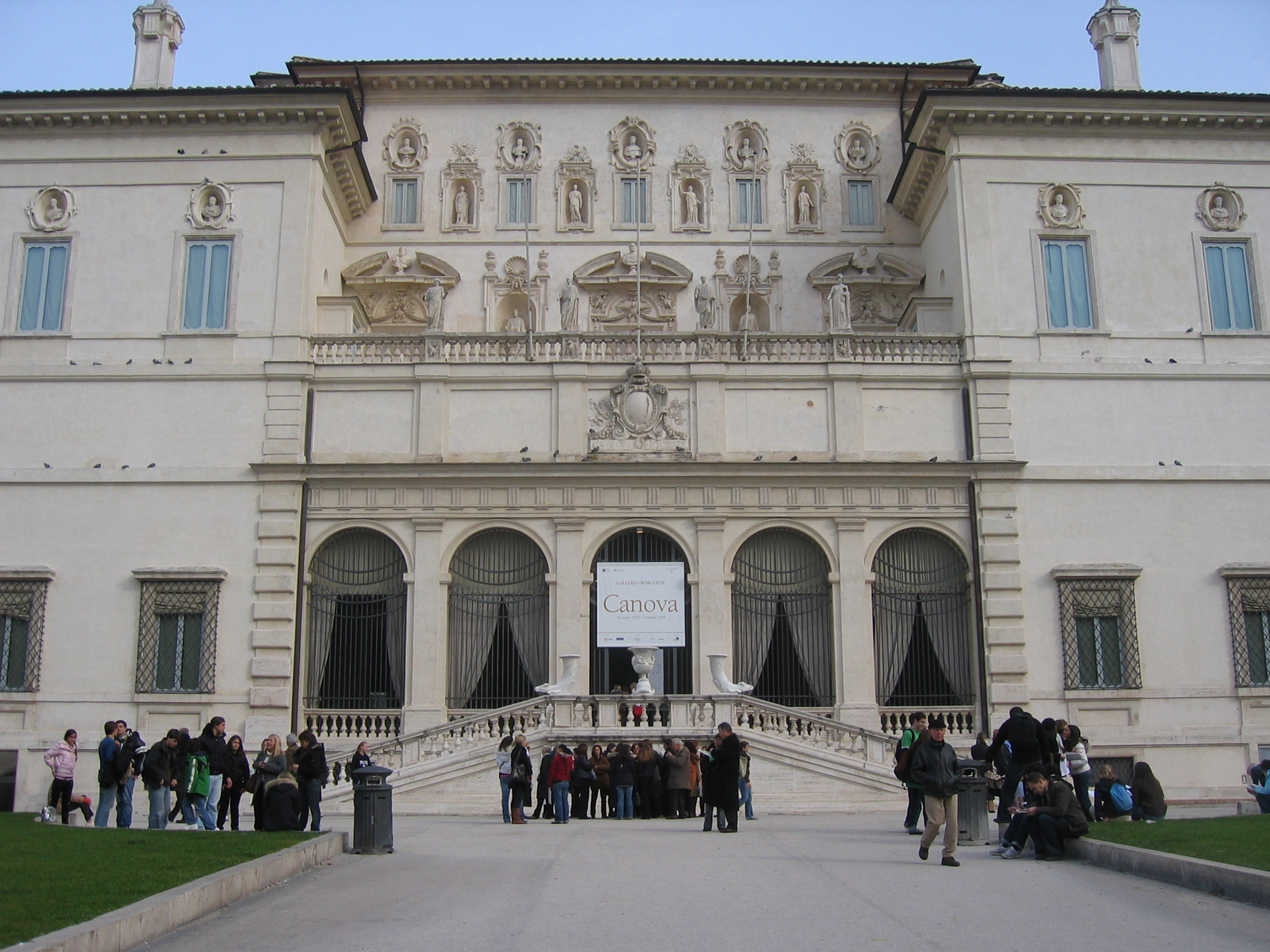
Galleria Borghese, Rome. Photo courtesy of the Alodie Larson.
Since it’s impossible to get someone with an art background to answer this question briefly, I must add that I also particularly admire the work of Eduard Vuillard, Mark Rothko, Grant Wood, James Turrell, William Morris, Daniel Burnham, Raymond Duchamp-Villon, Franz Kline, Xu Bing, and McKim, Mead & White. Closer to home, I have two favorite works of art that belong to me. The first is a watercolor sketch of Piccadilly Circus that I bought at a market in the courtyard of the Basilica of Sant’Ambrogio in Milan. With minimal strokes it evokes the London crossroads on a rainy night in the late 50s (back when Gordon’s Gin and Wrigley’s Chewing Gum took up prime real estate in the neon collage).

Piccadilly Circus in London, 1962. Photo by Andrew Eick. Creative Commons license via Wikimedia Commons.
The second is a watercolor illustration of “Dradpot the Inverted Drool” drawn by my grandfather, Max V. Exner. He devoted his life to music but was a terrific artist as well, and our family lore has it that he was offered a job with Walt Disney Studios in the 1930s when a member of the company saw him doodling in a restaurant.
Also, in a beautiful, financially responsible future, I will have enough disposable income to buy an original work by David Shrigley. I urge him to try to become less famous so that I can afford this.
What is your favorite article in Grove Art Online?
I’m grateful that this role allows me to learn about artists I’ve never studied, and my favorite articles to read are those on subjects with which I’m not particularly familiar. Our forthcoming update includes new biographies on an outstanding group of contemporary artists from Nigeria, Kenya, Sudan, Ghana, Senegal, and South Africa, which I have enjoyed.
I am partial to the articles written by some of my favorite architectural historians, particularly Leland M. Roth, whose Understanding Architecture (1993) is, I think, one of the most engaging introductory texts. His Grove article on the urban development of Boston gives a great overview of the subject. I also like David Watkin’s article on Sir John Soane. An excellent summary of Soane’s life and work, it is an absorbing narrative with entertaining flourishes. (“Despite Soane’s high professional standing, his idiosyncratic style was often ridiculed by contemporaries in such phrases as ‘ribbed like loins of pork’.”) I have always admired Soane’s work and his unconventional museum.

The breakfast parlour at Sir John Soane’s Museum as pictured in the Illustrated London News in 1864. Public domain via Wikimedia Commons.
What are some of the challenges of transitioning art history resources to an online environment?
Together, Grove and Benezit contain over 200,000 entries and images, and it is a challenge to organize that much information online in a clear, intuitive way that ensures researchers will find the articles they need. Many Grove entries first appeared in the print publication, The Dictionary of Art, and the article titles weren’t designed to fit well with modern keyword searches. Important essays can be buried within several layers of subheadings in long articles, sometimes with only date ranges as section titles. For a print work, it makes sense; you’d want all of the articles on a topic or region to be gathered together and located within the same physical volume. However, in an online environment, ideal heading structure would aid successful keyword matches and avoid cumbersomely long entries.
Despite the challenges, an online environment offers more powerful research options. Both Grove and Benezit are organized under a robust taxonomy, and this information allows users to narrow content by categories such as art form, location, or period. Rich search functionality and linking helps users to move between topics more swiftly than print research would permit. An online environment also allows our resource to respond quickly to new developments. We constantly update and expand the body of articles in our encyclopedia (though updates are not instantaneous, as our content is peer-reviewed, supervised by our distinguished Editorial Board and Editor-in-Chief, Dr. Nicola Courtright).
Oxford Art Online hosts thousands of images. Are there any challenges in hosting these on the site?
Yes, as with our articles, the volume of objects presents a challenge. Grove Art contains over 7,000 images, including many well-known artworks that would be discussed as part of an introductory survey course. Keyword searches usually connect researchers with the images relevant to their work, but we’re working to develop more powerful tools with which to both search and view images.
Obtaining image permissions can also be a challenge, but we are grateful for our partnerships with organizations like the Metropolitan Museum of Art, Art Resource, Bridgeman Art Library, and the National Gallery of Art, which have brought a rich group of images to Grove. Benezit, too, benefits from important partnerships with the Frick Art Reference Library and ArtistSignatures.com, which provide thousands of artists’ portraits and signatures on Oxford Art Online.
How do you envision art history research being done in 20 years?
I believe research in art history will become more collaborative, interdisciplinary, and international. Art libraries have undertaken enormously useful digitization projects, making objects in their collections available to scholars in far flung locations. I’m impressed with primary source projects like the collaboration between the Met and the Frick libraries to digitize the exhibition materials of the Macbeth Gallery, and Yale’s Blue Mountain Project, which digitized a collection of avant-garde art, music, and literary periodicals from 1848-1923. A number of other university libraries have excellent digital collections for art research, including the University of Washington, the Harry Ransom Center at UT Austin, Harvard University, University of Wisconsin, and Columbia University, which hosts the addictively interesting Robert Biggert Collection of Architectural Vignettes on Commercial Stationery.

Courtesy of The Biggert Collection of Architectural Vignettes on Commercial Stationery, Avery Architectural and Fine Arts Library, Columbia University.
Whether through local collections or collaborative projects like the HathiTrust, JSTOR, and the DPLA, libraries and publishers are bringing a terrific breadth of important materials online. As content becomes more accessible, I think researchers will select online resources based on the caliber of their material and on the functionality provided the platform. Even as publishers’ brands may fall further behind the façade of library discovery services, I believe scholars will continue to value sources they can trust to maintain high standards of quality.
Art has always been an interdisciplinary field, involving history, politics, economics, and cultural exchange. In the coming years, I think it will be important to emphasize how art connects with these other fields. With the current national focus on careers in science and technology, art is sometimes cast as an academic luxury, but it is not. Its study involves issues fundamentally relevant to all of us. In the words of Albert Einstein: “All religions, arts and sciences are branches of the same tree. All these aspirations are directed toward ennobling man’s life, lifting it from the sphere of mere physical existence and leading the individual toward freedom.”
Alodie Larson is the Editor of Grove Art and Oxford Art Online. Before joining Oxford, she studied the architecture of Georgian England at the Courtauld Institute of Art in London and worked for Random House and JSTOR.
Libraries are a vital part of our communities. They feed our curiosity, bolster our professional knowledge, and provide a launchpad for intellectual discovery. In celebration of these cornerstone institutions, we are offering unprecedented free access to our Online Resources, including Oxford Art Online, in the United States and Canada to support our shared mission of education.
Oxford Art Online offers access to the most authoritative, inclusive, and easily searchable online art resources available today. Through a single, elegant gateway users can access — and simultaneously cross-search — an expanding range of Oxford’s acclaimed art reference works: Grove Art Online, the Benezit Dictionary of Artists, the Encyclopedia of Aesthetics, The Oxford Companion to Western Art, and The Concise Oxford Dictionary of Art Terms, as well as many specially commissioned articles and bibliographies available exclusively online.
Subscribe to the OUPblog via email or RSS.
Subscribe to only art and architecture articles on the OUPblog via email or RSS.
The post A conversation with Alodie Larson, Editor of Grove Art Online appeared first on OUPblog.
Blog: OUPblog (Login to Add to MyJacketFlap)
JacketFlap tags: art, avant-garde, art history, art study, art school, apprentice, *Featured, Art & Architecture, Arts & Leisure, bauhaus, Online products, GAO, Grove Art Online, OAO, Oxford Art Online, academic art, Kandice Rawlings, dessau, Add a tag
By Kandice Rawlings
Summer is over and it’s back-to-school season. Art students are heading back to their classrooms and studios, receiving a course of training that will help them become professional artists. Much of the general public today likely has an image of the working artist as a glamorous intellectual, a socially-conscious provocateur, or a tradition-busting bohemian who has received a course of formal training, resulting in a fine arts degree. But these stereotypes and the reality they approximate—and the institutions that have contributed to it in one way or another—are relatively recent phenomena.
For most of history, the artist in the West (Europe and its colonies) was a craftsman who was trained as an apprentice in the workshop of a senior artist (‘master’). By working under the master and paying him a fee, an apprentice would learn the technical aspects of his craft—how to mix pigments, prepare wood panels for painting, or handle a chisel and hammer—as well as standard motifs and compositions that would suit his patrons. (I use the male pronoun here deliberately—professional women artists were unknown until the Renaissance period and were still extremely scarce until the 19th century.) After several years of training (usually in adolescence), an apprentice could apply for guild membership and open his own workshop.
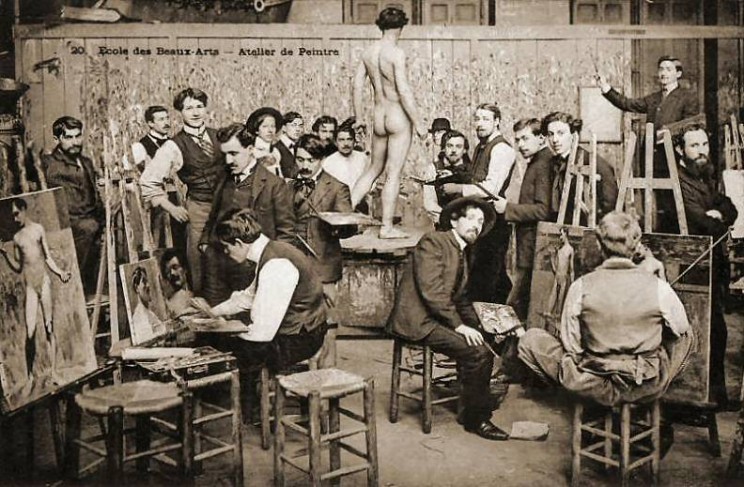
Students painting ‘from life’ at the École des Beaux-Arts, Paris. Late 1800s. Photograph in the public domain via Wikimedia Commons.
This model persisted in most of Europe until the 17th and 18th centuries, when state-sponsored art academies became widely established. The institution of the academy has its roots in Renaissance Italy, where humanist scholars, famous artists, and their patrons set out to reshape the visual arts as intellectual endeavors. While the medieval artist was a craftsman, the same as a cobbler or a weaver, the Renaissance artist—a good one, anyway—was a genius and a scholar. He (and, increasingly, she) therefore required a new kind of education, to learn about classical culture, literature, philosophy, theology, science, and mathematics, all of which were deemed essential to the production of good art. The first academy (named after Plato’s school in ancient Athens) was established in Florence in 1563, soon followed by one in Rome. By the end of the 18th century, every major European state boasted at least one academy of art. The National Academy of Design was founded in New York in 1825, based on the British model of independence from government involvement. The course of study at the academies was highly standardized and was based largely on classical forms and subjects, and the study of live models and plaster casts. Artists not trained at academies might instead learn similar skills in a successful artist’s studio, similar to the medieval master/apprentice relationship, with an updated curriculum.
By the late 19th century, after decades of political upheaval throughout Europe and the United States, the academy came to be seen by many artists as a sclerotic arm of the state. Academic artists turned out technically astute but formulaic work, some of it openly propagandistic. The emergence of the avant-garde prompted many artists to break institutional ties, forgoing academy-sponsored exhibitions (in France, these were the famous Salons) and trying to make their way without the help or influence of the establishment. (Thus the image of the artist as a struggling outsider was born.) In the late 19th and early 20th centuries, groups of artists established schools that were alternatives to the academy, such as the Art Students League in New York and the Bauhaus design school in Germany. A break from academic norms also opened doors for so-called self-taught artists with no formal training at all.

Exterior of the Bauhaus workshops, Dessau. Photo by PeterDrews (Own work). CC-BY-SA-3.0 via Wikimedia Commons.
How do artists fare after their formal education has finished? Statistics and studies from different countries provide a mixed picture, but a recent survey revealed that Americans holding fine arts degrees have a rate of unemployment (4%) well below the national average and report a high level of satisfaction in their jobs.
Kandice Rawlings is Associate Editor of Oxford Art Online at Oxford University Press. Before joining OUP, she studied Italian Renaissance art and taught art history at Rutgers University. Her students included many talented artists and performers studying at the Mason Gross School of the Arts.
Oxford Art Online offers access to the most authoritative, inclusive, and easily searchable online art resources available today. Through a single, elegant gateway users can access — and simultaneously cross-search — an expanding range of Oxford’s acclaimed art reference works: Grove Art Online, the Benezit Dictionary of Artists, the Encyclopedia of Aesthetics, The Oxford Companion to Western Art, and The Concise Oxford Dictionary of Art Terms, as well as many specially commissioned articles and bibliographies available exclusively online.
Subscribe to the OUPblog via email or RSS.
Subscribe to only art and architecture articles on the OUPblog via email or RSS.
The post Back to (art) school appeared first on OUPblog.
Blog: Ian Sands (Login to Add to MyJacketFlap)
JacketFlap tags: art history, prezi, Add a tag
Each time our little thief fills a pocket, another artist is identified. This story will help kids learn to recognize artists and their work through playful yet effective visual clues.
Blog: Ian Sands (Login to Add to MyJacketFlap)
JacketFlap tags: poem, art history, Add a tag
Blog: DRAWN! (Login to Add to MyJacketFlap)
JacketFlap tags: books, illustration, art history, ephemera, Add a tag

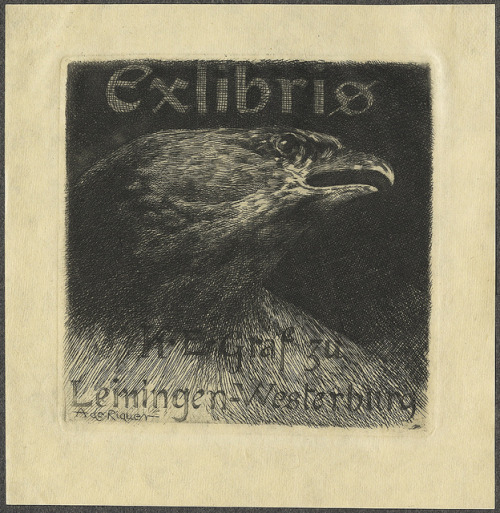
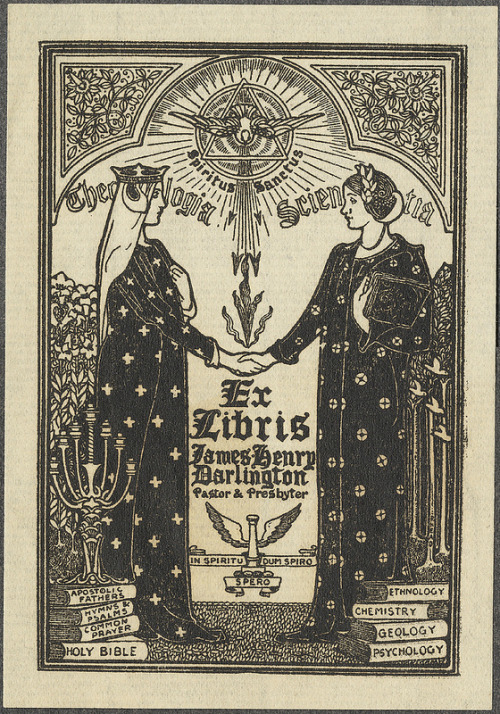

A nice collection of old bookplates over at BibliOdyssey, which remains one of the richest resources on the Internet.
Blog: DRAWN! (Login to Add to MyJacketFlap)
JacketFlap tags: animation, art history, Émile Cohl, Add a tag
Émile Cohl’s Fantasmagorie, from 1908, considered to be the first animated cartoon.
Blog: OUPblog (Login to Add to MyJacketFlap)
JacketFlap tags: vinci, martin kemp, swastika, kemp, channel_video_title, mona lisa, christ, martin, leonardo, Editor's Picks, *Featured, Art & Architecture, Arts & Leisure, christ to coke, coca-cola bottle, Videos, art, icons, art history, Media, branding, Multimedia, logos, leonardo da vinci, coca-cola, coke, Add a tag
Image, branding, and logos are obsessions of our age. Iconic images dominate the media. In his new book, Christ to Coke, art historian Professor Martin Kemp examines eleven mega-famous examples of icons, including the American flag, the image of Christ's face, the double helix of DNA, and the heart.
Blog: Emily Smith Pearce (Login to Add to MyJacketFlap)
JacketFlap tags: Siena, early Renaissance, Italian art, Travel, history, Art, Culture, Madonna, painting, art history, Renaissance, mother, Italy, Italian, Museum, nursing, La Leche League, breastfeeding, Add a tag
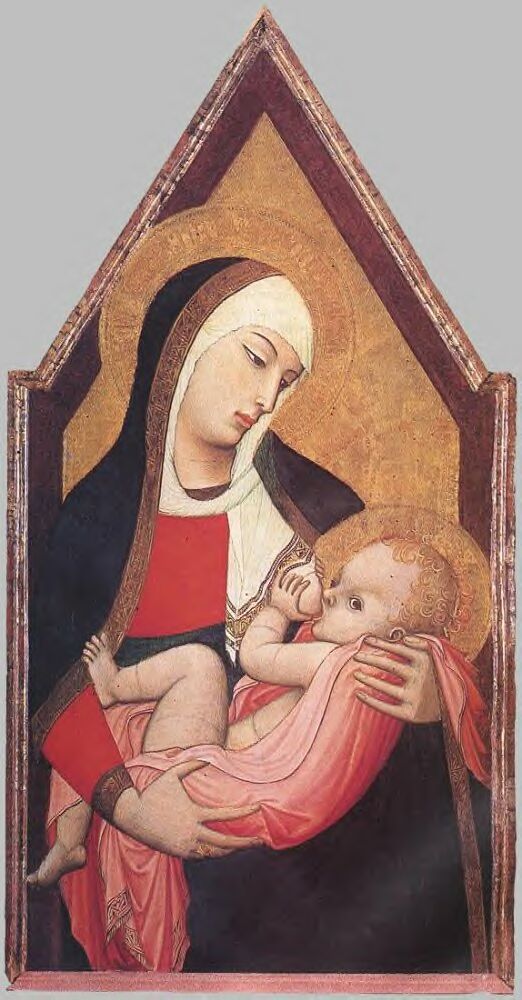
I really enjoyed the museums in Siena in part because they were small enough to manage with children, and not so packed. But the best part was their troves of early Renaissance art. I like the early stuff because it’s not so all-fired perfect like the late Renaissance art. During the early period, artists had figured out a few things about perspective, but they hadn’t yet cracked the whole code.
The art from the early period also seems brighter and more colorful than the later Renaissance. I find myself relating to it because it’s more like what I’d want to create myself. Perfection in artwork doesn’t really interest me that much, probably because I’m living after the invention of photography. So the beautiful but imperfect early Renaissance paintings (as well as pre-Renaissance works) have an almost modern feel to me.
Disclaimer: this isn’t an all that scholarly perspective, so bear that in mind.
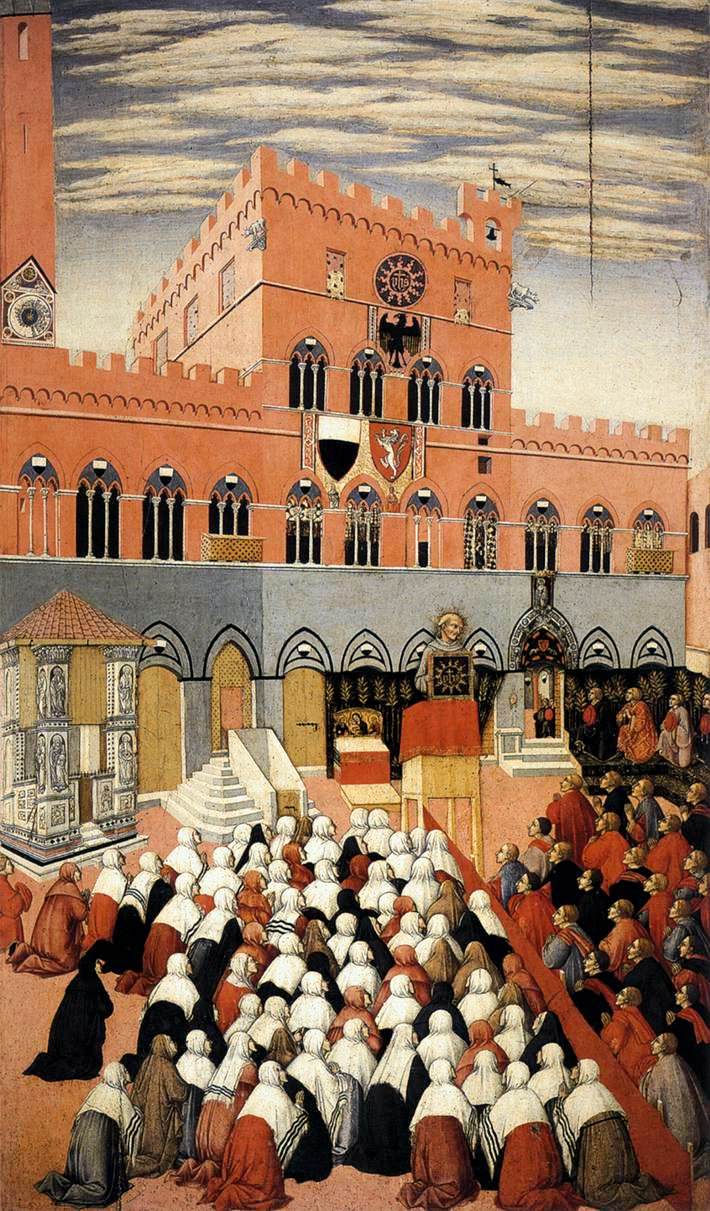
St. Bernardino Preaching, by Sano di Pietro (above)—This scene takes place in the same Piazza del Campo from my previous post. I couldn’t find a better image of it, but in real life the colors are much brighter. The building behind St. Bernardino is the color of papaya flesh.
(detail from The Siege of the Castle of Montemassi, by Simone Martini)
The image above is just a tiny bit of a beautiful and famous painting. You can see the artist has made an attempt to show the dimensionality of the castle, but it’s still a bit flat, with an almost cubist feeling. I love it.
Our favorite pieces in the museum were the nursing Madonnas. I had never seen anything like them and was so moved by their tenderness. Whoever thought of Mary breastfeeding Jesus? Evidently plenty of artists have, but I hadn’t. I found the images so intimate, so human. So different from some other Madonnas where she’s looking away from baby Jesus, holding him like she’s not sure whose kid this is but would someone please take him?
Evidently there are a lot of these lactating Madonnas from 14th century Tuscany. According to Wikipedia, they were “something of a visual revolution for the theology of the time, compared to the Queen of Heaven depictions.”

Madonna del latte, Paolo di Giovanni Fei
“During the Council of Trent in the mid-16th century, a decree against nudity was issued, and the use of the Madonna Lactans iconography began to fade away.”
Sigh. At least they didn’t burn them.
The coolest thing about seeing these paintings was how much my small children responded to them. I think the idea of baby Jesus being so like themselves, so like oth
Blog: DRAWN! (Login to Add to MyJacketFlap)
JacketFlap tags: illustration, art history, J.C. Leyendecker, Add a tag
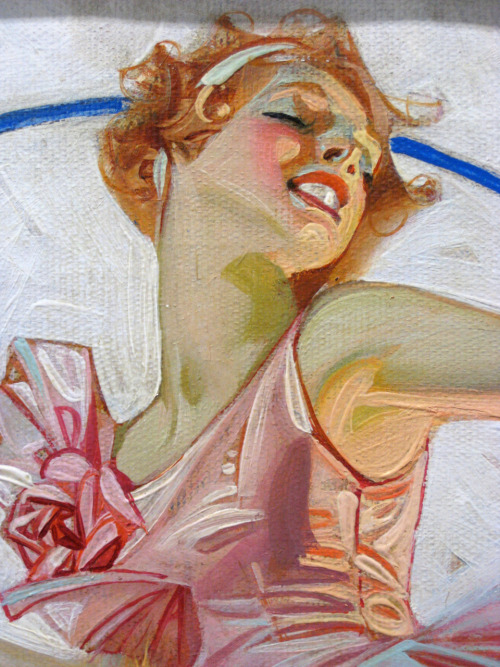
Illustrator Scott Anderson spent some time studying a few original Leyendecker covers for the Saturday Evening Post, and has posted a series of close-up photos on his blog. Clicking through to the full-res images reveals an incredible amount of detail, allowing you to truly study Leyendecker’s brushstrokes.
Blog: DRAWN! (Login to Add to MyJacketFlap)
JacketFlap tags: magic lanterns, art history, ephemera, Add a tag

Great Flickr set of Magic Lantern slides.
Blog: DRAWN! (Login to Add to MyJacketFlap)
JacketFlap tags: drawing, art history, Wonder Woman, William Moulton Marston, Harry G. Peter, Add a tag
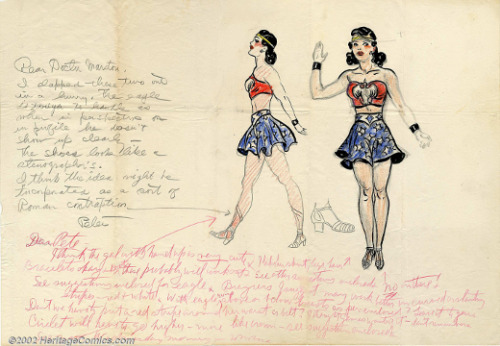
Recently found: original 1941 concept sketches for Wonder Woman.
Here we have a piece of comic book history from early-1941 in the form of a letter from cartoonist Harry G. Peter, written to William Moulton Marston, in which he unveils some very early sketches of Marston’s new superheroine, Wonder Woman; Marston’s handwritten response to Peter can also be seen, penned in red below the original message. Wonder Woman’s subsequent debut came just months later - December - in All Star Comics #8 (cover). The rest is history. Transcript follows. (via Letters of Note: The birth of Wonder Woman)
Blog: DRAWN! (Login to Add to MyJacketFlap)
JacketFlap tags: storytelling, humour, drawing, Disney, comedy, Walt Disney, art history, Add a tag

Letters of Note: How to Train an Animator, by Walt Disney
A letter written by Walt Disney in 1935 to Don Graham, tasking him with organizing art classes for the Disney animators. To put the timing in perspective, Snow White and the Seven Dwarfs was released in 1937, and Pinocchio and Fantasia in 1940.
Disney was a business tycoon, but he understood his business was in storytelling and emotion. From the letter:
Comedy, to be appreciated, must have contact with the audience. This we all know, but sometimes forget. By contact, I mean that there must be a familiar, sub-conscious association. Somewhere, or at some time, the audience has felt, or met with, or seen, or dreamt, the situation pictured. A study of the best gags and audience reaction we have had, will prove that the action or situation is something based on an imaginative experience or a direct life connection. This is what I mean by contact with the audience. When the action or the business loses its contact, it becomes silly and meaningless to the audience.
Blog: DRAWN! (Login to Add to MyJacketFlap)
JacketFlap tags: art history, Scott C, Rembrandt, illustration, art, Add a tag
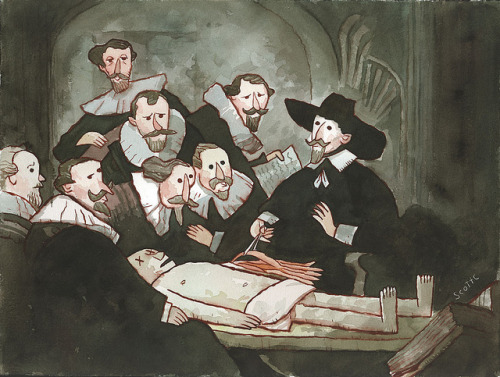
The Anatomy Lecture of Nicolaes Tulp (by Scott Campbell)
While I think this image speaks for itself, check out Scott’s process documented on his blog.
Blog: Eric Orchard (Login to Add to MyJacketFlap)
JacketFlap tags: paintings, art history, matisse, nscad, Add a tag
“Every corner of the canvas should be alive,” Said Henry Matisse and I think he was right. I guess you can't always take everything into account on a tight deadline but I always try. I had forgotten the wording of this quote until I read this article. This was also taught to me at art school (Nova Scotia College of Art and Design) I'm not sure which teacher said it but to paraphrase them " You should be able to remove a square inch from anywhere in your paining and have it be as beautiful as any other," I'm probably getting it wrong but it's always stuck with me.
View Next 25 Posts






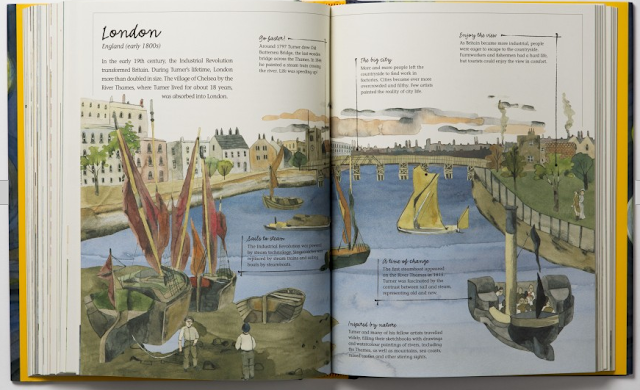

























































Ehhh that's fine art mumbo jumbo though. Don't get caught up in that.
It's beautiful and true.
If you're going to spend so much time painting something, you might as well care that much about it. I think he's right. If you think about it, it's true for both Van Gogh and Pollock, for instance.
That's not so much "fine art mumbo jumbo" as a question of basic craft. Give every part of your image attention. There's nothing esoteric about it.
thanks eric for taking a look at my site!